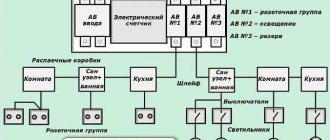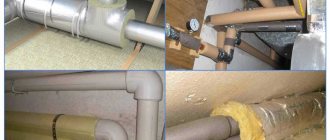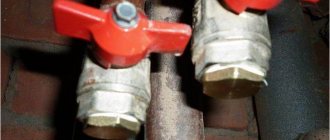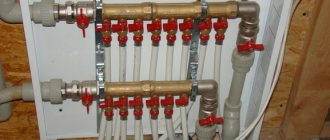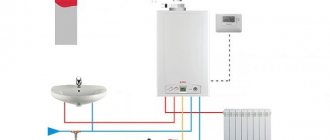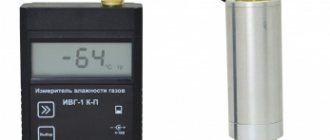Electrician in the house
Encyclopedia about electricity from A to Z
Masters catalog
Find the best master or company in your city
Difavtomats perform a double function (protect against electrical leaks and short circuits) and completely replace the set of RCD and circuit breaker. When choosing a differential, you must consider the following characteristics:
- Circuit breaker rating (A);
- Leakage at which the mechanism is triggered (mA);
- Trip characteristic (“A” or “AC”);
- Type of mechanism (electronic or electromechanical);
- Release characteristics of the machine (B or D).
But how to choose specific values? Taking the opportunity, and not for the first time turning to our electrical engineering expert, I decided to ask him these questions. Namely, the engineer, and part-time specialist in the sale of differential protection, Sergei from the AxiomPlus online electrical equipment store. And this time, although reluctantly, he carried out another educational program.
- How to calculate and determine the right automatic machine for yourself?
- Which release rating should I choose?
- Trip characteristic "A" or "AC"?
- Which type of release should I choose?
- Select the release characteristic of the machine: “B” or “C”
Which release rating should I choose?
Based on the amount of leakage, difavtomats (like RCDs) are divided into two types:
- protecting against electric shock and fire (10-30 mA);
- fireproof (above 30 mA).
As a rule, sockets and lighting are protected by 30 mA diodes (the average person can withstand such a discharge). 10 mA is a safe value and absolutely harmless to the health and life of anyone, even a child. 10 mA difautomatic devices, as a rule, protect bathrooms and children's rooms.
They are not placed on socket groups, since electrical appliances with microcircuits can allow small differential leaks, giving a total of more than 10 mA, to which the differential can react. To protect only lighting or one outlet, this will be enough, the main thing is not to turn on extension cords with a large accumulation of consumers.
At least 30 mA is required at the input. For large houses they install 100 mA, but behind it, using the selectivity method, 30 mA and 10 mA difautomatic devices are installed, since not all people can withstand 100 mA.
Advantages and disadvantages
The advantage of the difavtomat is its compactness, versatility, 100% protection of the circuit from sudden overloads or other dangers. Well, the main “trump card” is the cost, which is lower than the total cost of the RCD and automatic type switch.
If you take into account a single case, the difference is not very noticeable, but when buying for the whole house, the benefit is significant. However, a lot depends on the brand of the product. Installation takes little time; the difavtomat also fits quite compactly on the rail.
Automats also have their drawbacks. If it fails, you will have to purchase the product as a set, and not separately.
The occurrence of a short circuit will lead to difficulties in finding its cause. With a divided installation, identification is much simpler: the RCD is turned off - leakage, the circuit breaker - short circuit.
Which type of protective device to choose is not an easy question. As many electricians do: if we are talking about a small apartment, then use a difavtomat.
When you are going to install complex structures, it is best to install separate RCD units and automatic type switches in a group. Moreover, each group must have its own separate switch.
Trip characteristic "A" or "AC"?
The more popular “AC” type operates exclusively on alternating current with a sine wave curve. Most often this occurs due to damage to the insulation of household appliances (refrigerators, washing machines, boilers, etc.) when the exposed phase touches the metal body.
But sometimes leaks occur in electrical appliances for which differential protection does not respond. For example, it does not respond to direct or pulsating current generated in electronics power supplies. Nevertheless, “AC” is the simplest and most common differential, and such protection is also 30% cheaper than “A”. As a rule, they are marked on the case with an icon in the form of a sine wave.
“A” is a more sensitive release that prevents any leakage, including pulsating and direct currents, generated in electronics with microcircuits filled with semiconductors (resistors, thyristors, diodes, etc.). This is a more sensitive protection. Marking in the form of a sinusoid on top and two curves on the bottom.
European countries are gradually abandoning "AC", switching to "A", as more reliable and safe. Nevertheless, “AC” can be freely used for electrical appliances without electronic “stuffing”. The instructions for some electrical appliances indicate that they can only be protected by an RCD (or automatic circuit breaker) of type “A”.
Differences between protective devices
It is necessary to distinguish between a device in the form of a difavtomat and a residual current device. At first glance, there is no particular visible difference, but this is not so.
The RCD is used to de-energize the network when the slightest leak in the circuit is detected. For example, if an electrical cable is damaged, in order not to injure a person, the circuit will be turned off.
The difavtomat, in addition to the RCD, is equipped with a built-in automatic type switch. It serves to de-energize the system, prevent short circuits, overload the circuit, in general. In a word, it's two in one.
A conventional circuit breaker (circuit breaker) protects the circuit from overload, but it cannot create a safe environment for humans. Therefore, in modern buildings either difautomatic devices are installed, or RCDs and automatic devices are installed together.
The selection of any protective device depends on the characteristics of the network. Primarily from the load connected to it. Therefore, it is important to know how to calculate the power of the machine based on the load.
Which type of release should I choose?
Based on their internal design, differentials and RCDs are divided into two types: electronic and electromechanical. Contrary to popular belief, the type of release does not affect the operating parameters and technical characteristics. What's the difference between them?
The electromechanical release is triggered by a differential transformer. When a leak occurs in its secondary winding, a voltage appears that acts on the polarized relay, which releases the contacts.
The electronic one is triggered only when there is voltage on the phase. The case contains a microcircuit with an amplifier, powered from an external network. If there is a loss of electricity, the microcircuit sends a signal to the shutdown mechanism, which releases the phase. This scheme is cheaper.
The main difference is that if the network is de-energized, the electronic differential will not work. But is a leak possible in this case? Purely theoretically, yes, due to the energy accumulated in capacitors of electronics connected to the network. These are very rare cases, and rather exceptions to the rule.
On forums you can often find complaints about the reliability of electronic automatic machines, which supposedly do not always work. In most cases, this is due to incorrect connection. According to the PUE, both phase and zero must be connected to the differential protection. If you do not connect the zero, it will work like an automatic machine, but there is no guarantee that it will work like an RCD. Conclusion: if connected correctly, everything will work, regardless of the design of the release.
Basic errors in connecting difavtomats
Sometimes, after connecting the difavtomat, it does not turn on or turns off when any load is connected. This means that something was done wrong. There are several common mistakes that occur when assembling the shield yourself:
- The wires of the protective zero (ground) and the working zero (neutral) are combined somewhere. With such an error, the automatic machine does not turn on at all - the levers are not fixed in the upper position. We will have to look for where “ground” and “zero” are combined or confused.
- Sometimes, when connecting a difavtomat, the zero for the load or for lower-lying machines is taken not from the output of the device, but directly from the zero bus. In this case, the switches are in the working position, but when you try to connect the load, they are instantly turned off.
- From the output of the difavtomat, zero is not supplied to the load, but goes back to the bus. Zero for the load is also taken from the tire. In this case, the switches are in the working position, but the “Test” button does not work and when you try to turn on the load, a shutdown occurs.
- The zero connection is mixed up. From the zero bus, the wire must go to the corresponding input, designated by the letter N, which is located at the top, not down. The wire should go to the load from the lower neutral terminal. The symptoms are similar: the switches turn on, the “Test” does not work, and when the load is connected, it triggers.
- If there are two automatic circuit breakers in the circuit, the neutral wires are mixed up. When such an error occurs, both devices are turned on, “Test” works on both devices, but when any load is turned on, both machines are knocked out at once.
- If there are two automatic machines, the zeros coming from them are connected somewhere further. In this case, both machines are cocked, but when you press the “test” button on one of them, two devices are switched off at once. A similar situation occurs when any load is turned on.
Now you can not only select and connect a differential circuit breaker, but also understand why it is tripping, what exactly went wrong and correct the situation yourself.
Select the release characteristic of the machine: “B” or “C”
The most popular differential models have the following release characteristics: “B” is the most popular option. Characterized by minimal response delay. Suitable for domestic use in houses with old wiring. Not recommended for networks supplying equipment with high starting currents (washing machines, pumps, refrigerators, concrete mixers, etc.). Short-term excess loads provoke the so-called. false alarm. Instantly triggers at currents equal to 3-5 rated; “C” is a universal option, a good solution for private homes. It has a longer delay before operation, so it does not respond to high inrush currents. It is recommended to select for networks with a large accumulation of powerful electrical equipment running on electric motors. Instantly triggers at a load 5-10 times higher than the rated load.
Type “B” is best used for lines without powerful consumers, and type “C” is more suitable for outlet lines with a load of 1 kW or more.
To maintain selectivity, it is advisable to set “C” at the input, and “B” at the outlet lines and lighting, so that in case of short circuits the input differential does not operate before the group ones.
Selection of machine by power
The choice of protective circuit breakers is made not only during the installation of a new electrical network, but also when upgrading the electrical panel, as well as when additional powerful devices are included in the circuit, increasing the load to a level that old emergency shutdown devices cannot cope with.
And in this article we will talk about how to correctly select a machine based on power, what should be taken into account during this process and what are its features. Failure to understand the importance of this task can lead to very serious problems.
After all, users often do not bother themselves when choosing a circuit breaker based on power, and take the first device they come across in the store, using one of two principles - “cheaper” or “more powerful”.
This approach, associated with the inability or unwillingness to calculate the total power of devices connected to the electrical network and select a circuit breaker in accordance with it, often becomes the reason for the failure of expensive equipment due to a short circuit or even a fire.
What are circuit breakers for and how do they work?
Modern AVs have two degrees of protection: thermal and electromagnetic. This allows you to protect the line from damage as a result of prolonged excess of the flowing current of the rated value, as well as a short circuit.
The main element of the thermal release is a plate made of two metals, which is called bimetallic. If it is exposed to a current of increased power for a sufficiently long time, it becomes flexible and, acting on the disconnecting element, causes the circuit breaker to operate.
note
The presence of an electromagnetic release determines the breaking capacity of the circuit breaker when the circuit is exposed to short-circuit overcurrents, which it cannot withstand.
This makes it possible to protect the wire and devices from an electron flow, the value of which is much higher than that calculated for a cable of a particular cross-section.
What is the danger of a cable mismatch with the network load?
Selecting the correct power circuit breaker is a very important task. An incorrectly selected device will not protect the line from a sudden increase in current.
But it is equally important to choose the correct cross-section of the electrical cable. Otherwise, if the total power exceeds the rated value that the conductor can withstand, this will lead to a significant increase in the temperature of the latter. As a result, the insulating layer will begin to melt, which can lead to a fire.
To more clearly imagine the consequences of a mismatch between the wiring cross-section and the total power of the devices connected to the network, let’s consider this example.
New owners, having bought an apartment in an old house, install several modern household appliances in it, giving a total load on the circuit equal to 5 kW. The current equivalent in this case will be about 23 A. In accordance with this, a 25 A circuit breaker is included in the circuit.
It would seem that the choice of machine in terms of power was made correctly, and the network is ready for operation. But some time after turning on the appliances, smoke appears in the house with a characteristic smell of burnt insulation, and after a while a flame appears.
The circuit breaker will not disconnect the network from the power supply - after all, the current rating does not exceed the permissible one.
Important
If the owner is not nearby at this moment, the melted insulation will cause a short circuit after some time, which will finally trigger the machine, but the flames from the wiring may already spread throughout the house.
So that you do not have to take out a calculator and independently calculate the cross-section of electrical wiring using formulas, we present a standard table in which it is easy to find the desired value.
Weak link protection
So, we are convinced that the calculation of the circuit breaker should be made based not only on the total power of the devices included in the circuit (regardless of their number), but also on the cross-section of the wires. If this indicator is not the same along the electrical line, then we select the section with the smallest cross-section and calculate the machine based on this value.
The PUE requirements state that the selected circuit breaker must provide protection for the weakest section of the electrical circuit, or have a current rating that will correspond to a similar parameter for the installations connected to the network. This also means that the connection must be made using wires with a cross-section that can withstand the total power of the connected devices.
How to select the wire cross-section and rating of the circuit breaker - in the following video:
If a careless owner ignores this rule, then in the event of an emergency that arises due to insufficient protection of the weakest section of the wiring, he should not blame the selected device and scold the manufacturer - only he himself will be to blame for the current situation.
How to calculate the rating of a circuit breaker?
Let's assume that we took into account all of the above and selected a new cable that meets modern requirements and has the required cross-section.
Now the electrical wiring is guaranteed to withstand the load from switched on household appliances, even if there are quite a lot of them. Now we proceed directly to the selection of a circuit breaker based on current rating.
Advice
Let's remember the school physics course and determine the calculated load current by substituting the corresponding values into the formula: I=P/U.
To simplify the selection of a circuit breaker and save you from the need to use a calculator, we present a table that shows the ratings of the circuit breakers that are included in single-phase and three-phase networks and the corresponding total load power.
This table will make it easy to determine how many kilowatts of load correspond to which rated current of the protective device.
As we can see, a 25 Ampere circuit breaker in a network with a single-phase connection and a voltage of 220 V corresponds to a power of 5.5 kW, for a 32 Ampere circuit breaker in a similar network - 7.0 kW (this value is highlighted in red in the table).
At the same time, for an electrical network with a three-phase delta connection and a rated voltage of 380 V, a 10 Amp circuit breaker corresponds to a total load power of 11.4 kW.
Visually about the selection of circuit breakers in the video:
Conclusion
In the presented material, we talked about why electrical circuit protection devices are needed and how they work. In addition, taking into account the information presented and the tabular data provided, you will not have any difficulty with the question of how to choose a circuit breaker.
Classification of washing machine drive overloads
Is your washing machine breaking plugs? In many cases, this is caused by incorrect operation of equipment and violation of the terms of its routine maintenance.
Washing machine overloaded
The user’s mentality of “why not put another towel in there” in practice does not speed up, but slows down the wash. When overloaded, the movement of things in the tank is limited and slowed down, so dirt removal is unsatisfactory.
Moreover, things do not receive enough washing powder. It is worth recalling that a detergent is a combination of surfactants that have the property of removing dirt, grease (and, by the way, germs) to the surface of the fabric. There, these harmful components become quite slippery, shake off with a cloth and pass into the soap solution. Unfortunately, this does not happen when the machine is overloaded.
Overload affects not only the items being washed, but also the mechanical design elements typical of a washing machine. Engine and tank bearings are especially affected. Additional loads for which they are not designed lead to jamming and stopping of the rotating drum, the replacement of which is expensive.
The unwritten law says - fill the washing machine tank no more than ¾ of the recommended volume, and operational failures will disappear by themselves. And use only those types of detergents that are recommended specifically for automatic washing!
Poor technical condition of the washer hose
The durability of the hose is limited to no more than five years of operation (it all depends on the intensity of washing). After this, it is unsafe to use the hose: it, as a rule, weakens and can become twisted under the influence of vibration of the machine drive. Let's take into account natural wear and tear and come to the conclusion: a leaky hose will allow an aqueous solution to pass into the body of the washing machine, after which the cause of the short circuit is obvious.
Motor overload
The characteristics of any type of electric motor for washing machines is a certain excess of the starting torque values in relation to the nominal one. However, when overloaded, the starting energy parameters increase sharply, which leads to extreme (“peak”) current consumption.
In general, washing machine motors are built to last and, with proper preventive maintenance, are designed to last the long life of the machine. Engine failure most often occurs for the following reasons:
- Dirt accumulation. Dirt can get into the engine starting switch, causing the moving contacts to close, or, conversely, preventing the contacts from closing reliably. In the first case, the engine does not start at all, but simply hums loudly and consumes an extremely high amount of power. If the circuit breaker does not trip, then operating the motor in this mode will burn its windings. In the second case, the high resistance connection causes a voltage drop that prevents the starting winding from receiving full voltage. Either way, if the situation continues long enough, the motor windings will burn out.
- Worn bearings. They increase the load on the engine and lead to its premature failure. This applies to any type of bearings - in the drive of the washing machine, in the tank or sliding bearings in the engine itself. A burnt out engine usually cannot be repaired.
- Washing machine drive belts. These are V-belts, similar to those used in some brands of cars. Even with normal use, they will wear out over time and require replacement. It is important to ensure the correct belt tension, since a belt that is too tight will put pressure on the engine plain bearings, causing damage.
Having identified the reasons, let's move on to the consequences.
What to look for when choosing a machine
All so-called “packets” differ not only in the maximum current at which they turn off, but also have a certain delay class. What does it mean? The class, lettered “B”, “C”, “D” and so on, determines the time of a possible power surge, after which the device turns off. In the case of connecting a compressor refrigerator, this indicator must be taken into account, since the motor, when starting, consumes 3-5 times more power than in normal mode.
The nominal consumption of the compressor is about 800 W, but if you install the machine based on this indicator without a shutdown delay, then when the motor starts, the network will be cut off and the device will not be able to function. Therefore, the best choice for a refrigerator would be a 4-5A electric machine with class “C”. This will ensure stable operation of the device, and if any overload occurs, protect the device and the electrical network from fire.
The feasibility of installing individual AVs
Typically, equipment such as a boiler or air conditioner is connected separately. Often not even through the outlet, but directly to the panel. Considering the high power of the consumers listed above and the high probability of failure inside the case, they should be protected separately.
For example, imagine that a water station breaks down and a phase accidentally comes into contact with zero. There was a short circuit and the electricity was knocked out. The light has disappeared throughout the house, you turn the handle and the release is knocked out again. In this case, the source of the accident will have to be looked for for a very long time, and during the repair the entire protected group will be de-energized, possibly even the lighting.
If the same automatic machine together with the station protects the refrigerator, then you will have to urgently defrost it, otherwise a flood and a lot of spoiled food will await you in the kitchen.
Now imagine that the water station is protected separately. You will immediately see where the breakdown is and can begin repairs as soon as possible. At the same time, the home’s network will not be de-energized, and sockets, lighting and other equipment will continue to work as before.
Powerful consumers connected directly or for which a special socket is allocated must be protected individually.
In this case, it is recommended not to plug other equipment into specially designated sockets, since the parameters of the release are not designed for it. For example, if there is an outlet for a washing machine in the bathroom, then it is better to make a separate one for a hairdryer, electric razor, etc., connected to a group machine.
Domestic models
KEAZ is a domestic manufacturer of differential circuit breakers and other protection devices. The quality is average, but the products come with a two-year warranty. The price is 1000-1500 rubles for single-phase products.
IEK is also a domestic brand. The products are in great demand due to the successful combination of price and quality. In fact, product shortcomings, such as imperfect terminals, noise during operation, are compensated by the price of 700-1000 rubles for single-phase products.
DEKraft is another Russian brand. The company was formed relatively recently. The quality of the products leaves much to be desired, but at the same time the products comply with Russian standards. The disadvantage is the short service life of the products. Considering the low price (600-1000 rubles), contractors willingly use products of this brand for installation on low-budget projects.
Many manufacturers often produce budget automatic machines, and even entire lines of models with low prices. Therefore, when choosing, it is recommended to carefully study product catalogs.
Of course, when choosing a differential machine, you need to focus not only on price and manufacturer. The operating conditions of the device must be taken into account.
It is possible to use devices with a lesser degree of reliability in utility rooms, where the specific time of use of electrical wiring is small. If the need for such automatic machines is great, then the cost savings can be significant.
Refrigerators of the British brand MAUNFELD
When choosing a new refrigerator for your kitchen, you should pay attention to the products of the famous British brand MAUNFELD. Devices of this brand are equipped with modern, high-tech components and assemblies, which guarantees uninterrupted operation for many years. For example, compressors installed in devices of this brand are assembled at the production facilities of the Italian concern ACC. Engines from this manufacturer have the highest reliability, thanks to the introduction of high-strength materials in the design, and the manufacturer guarantees 10 years of trouble-free operation. In addition to reliability, MAUNFELD refrigerators have low energy consumption with high performance, which significantly reduces energy costs.
All devices of this brand are equipped with electronic control. This makes them simple and intuitive to operate, and also helps maintain optimal temperatures in the chambers, preserving the quality of the products.
Introductory diffautomat.
The house was built in 1982, there is no land. The electricians installed new electrics in the apartment; all sockets are supplied with a three-wire cable. The yellow-green in the dashboard was set to zero, i.e. nullified. They want to install a 25A 30mA diffautomatic circuit breaker (maybe more is needed), will it protect the devices when the zero burns out?
Asks
Paul
Masters online: 463 Orders per week: 943 Offers per day: 1,113
It is better to disconnect the grounding wire, since many people make grounding in their apartment by connecting a ground wire to a battery or a pipe in the bathroom, the differential machine works normally without grounding, and with grounding you risk getting burned, since in most cases one of your neighbors is grounded/grounded to pipes. In general, do not connect the ground wire and everything will work fine and with an ouzo it will also be safe.
If you turn off the PE at the entrance, you will have to turn it off from all sockets. Otherwise, dangerous potential may appear on the housings of the devices.
That is, just disconnect the grounding wire and install sockets without ground, and if the plugs on the devices have an outlet to the ground, or is it okay?
No. It is necessary to disconnect the grounding contact at the sockets.
What is the section of the risers? House with electric stoves? Post a photo of the floor board. It will not protect you from zero burnout. When the zero burns out, a dangerous potential of 380 volts is formed at the zero, and your devices will still burn out, since everything passes through the ouzo anyway. To protect against burnout, install UZM-51 as input. Also, if you have differential protection for outlet lines in the apartment panel, you should install a 25A RCD at the input (depending on the allocated power) with a leakage of 300mA.
House with gas stoves. In the floor panel there is now an old machine and a meter, after which it is planned to install a differential, the electrician says that it will work precisely from the potential difference, i.e. when at zero it will be 380. Today I went to one of the electrical stores, there was no UZM-51 there.

